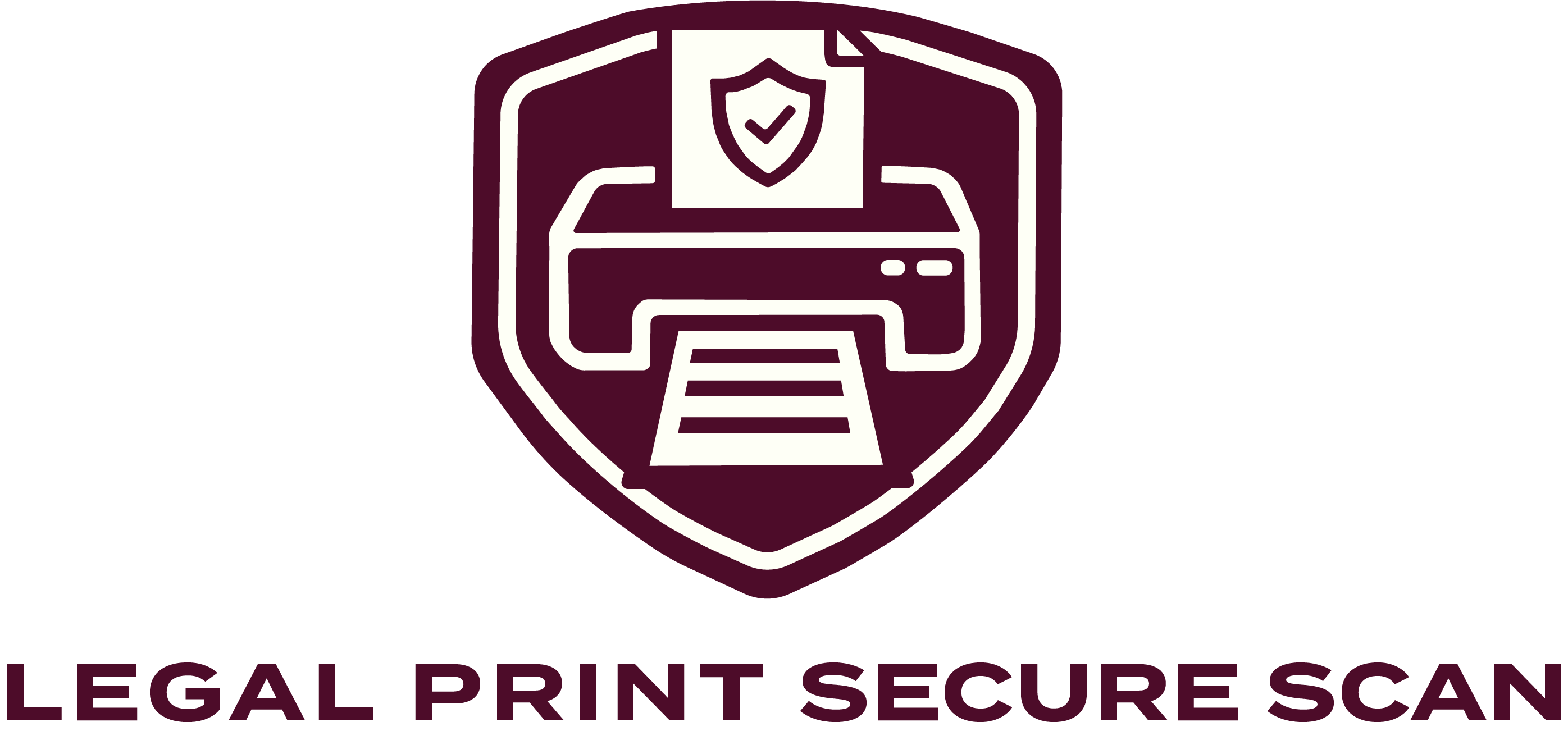
In today’s digital world, the legal industry is moving away from traditional paper documents to digital ones. A key part of this change is document scanning. Scanning makes documents easier to manage, secure, and access, but it also brings new legal challenges, especially when these scanned documents are used as evidence in court. This raises important questions: Are scanned documents allowed as evidence? How do we check their authenticity? And what rules must be followed to ensure they are accepted in legal proceedings?
This blog post, designed for Legal Print Secure Scan, examines the legal implications of scanned documents, focusing on three key pillars: chain of custody, authenticity, and compliance with evidentiary standards. By understanding these concepts, legal professionals and document management providers can more effectively navigate the intersection of law and digital technology.
Legal Foundations of Digital Evidence
To understand the legal status of scanned documents, it’s important to know the rules governing electronic and digital evidence. In the United States, key laws include the Federal Rules of Evidence (FRE), the Uniform Rules of Evidence, and state evidentiary codes. Many countries also follow similar standards based on the United Nations Commission on International Trade Law (UNCITRAL) or the EU eIDAS Regulation.
Scanned documents are considered digital copies. According to FRE 1001(d), copies can be used in court just like the original, unless there is a real question about the original’s authenticity. This means scanned documents can be accepted in court if they meet certain criteria.
Chain of Custody: Establishing Document Integrity
The concept of chain of custody originates from criminal law, where it is used to ensure that physical evidence is collected, stored, and presented without alteration. In the context of scanned documents, the principle remains the same: to prove that the digital document is an accurate and untampered reproduction of the original.
What Is Chain of Custody in Scanned Documents?
For scanned documents, chain of custody refers to the documented process that tracks a document’s lifecycle—from the moment the paper version is scanned to its digital storage, access logs, and usage in legal proceedings. This is especially critical in sensitive cases, such as financial fraud, corporate litigation, or government compliance audits.
Best Practices for Maintaining Chain of Custody
- Timestamped Scanning: Use of software that records the exact date and time of scanning.
- Audit Trails: Implementation of digital logs that record who accessed or modified the scanned document.
- Secure Storage: Use of encrypted servers or cloud-based systems with limited access.
- Document Hashing: Applying cryptographic hashes to scanned documents to detect alterations.
Legal Relevance
Courts will consider whether the scanned document could have been altered or substituted. A weak chain of custody may result in the document being deemed inadmissible. Conversely, a strong, verifiable chain enhances the credibility of the scanned document, making it more likely to be accepted as reliable evidence.
Authenticity: Proving the Document Is What It Claims to Be
Authenticity is another cornerstone of admissibility in legal settings. FRE 901(a) states that “to satisfy the requirement of authenticating or identifying an item of evidence, the proponent must produce evidence sufficient to support a finding that the item is what the proponent claims it is.”
Methods of Authenticating Scanned Documents
There are several methods to authenticate a scanned document:
- Witness Testimony: A person familiar with the original document can testify that the scanned version is a true and accurate reproduction.
- Digital Signatures: Embedding cryptographic signatures that verify the origin and integrity of the document.
- Metadata Analysis: Providing metadata that supports the creation and modification timeline of the document.
- Certification by Custodian of Records: An affidavit from the records custodian verifying the scanning and storage process.
The Role of Forensics
In some cases, digital forensics experts may be called upon to authenticate a document. This is particularly important if the opposing party challenges the scanned document’s legitimacy. Forensic examination can reveal traces of tampering, inconsistencies in metadata, or anomalies in digital signatures.
Risks of Inauthentic Scanned Evidence
Failing to establish authenticity can lead to serious legal consequences, including:
- Exclusion of Evidence: The judge may rule the document inadmissible.
- Contempt or Sanctions: If tampering is suspected, legal sanctions or ethical violations could follow.
- Loss of Case Credibility: A failed authentication could weaken a party’s case in the eyes of the judge or jury.
Compliance with Evidence Standards
Beyond authenticity and chain of custody, scanned documents must comply with specific evidence rules that vary by jurisdiction. Legal professionals and scanning service providers must understand these to ensure scanned documents are not just admissible but persuasive.
The Best Evidence Rule
Under FRE 1002, the Best Evidence Rule requires that the original document be produced when the contents are at issue. However, FRE 1003 permits duplicates unless there’s a legitimate dispute about authenticity.
Exceptions Allowing Scanned Documents:
- The original is lost or destroyed (not in bad faith).
- The original is not obtainable by judicial process.
- The scanned document is an accurate copy verified by a credible witness.
Hearsay Considerations
Many scanned documents fall under the hearsay category if they contain out-of-court statements. However, exceptions such as business records (FRE 803(6)) can allow these documents in if:
- They were made in the course of a regularly conducted business activity.
- A custodian can verify their authenticity.
- They were kept in the regular course of business.
eDiscovery Compliance
Under Federal Rules of Civil Procedure (FRCP) Rule 34, scanned documents requested in discovery must be produced in a “reasonably usable form.” Legal teams should ensure that scanned documents retain quality, searchability (via OCR), and proper indexing for this purpose.
Real-World Case Studies
Case 1: United States v. Bennett (2015)
In this case, scanned emails and financial documents were submitted as evidence. The defense challenged their authenticity, arguing potential manipulation. However, the prosecution demonstrated a strong chain of custody with secure logs and metadata, leading to the court accepting the evidence.
Case 2: SEC v. Bankosky (2012)
Here, scanned trading records were key to the SEC’s insider trading claims. The SEC successfully authenticated the documents using internal procedures and digital certification from the firm’s IT department. The court admitted the scanned documents under the business records exception.
The Role of Legal Print Secure Scan
Legal Print Secure Scan plays a vital role in bridging the gap between physical and digital legal documentation. Through best-in-class scanning technology, secure digital storage, and robust audit trails, the company ensures that scanned documents meet all legal standards for evidentiary use.
Services That Support Legal Admissibility
- Tamper-Proof Document Conversion: Ensures no data is lost or altered during scanning.
- Digital Watermarking and Hashing: Adds a layer of authenticity verification.
- Chain of Custody Documentation: Detailed logs and access control systems.
- Compliance Training and Support: Equips clients with tools to understand admissibility standards.
By adhering to legal standards and investing in secure digital processes, Legal Print Secure Scan empowers law firms, courts, and businesses to handle sensitive documents with confidence.
As the legal system becomes increasingly digital, the scrutiny applied to scanned documents is intensifying. Legal professionals must understand that the admissibility of these documents depends on more than simply presenting a digital copy. It requires clear documentation of the chain of custody, verifiable authenticity, and strict compliance with evidentiary rules.
For document management services like Legal Print Secure Scan, this situation presents both challenges and opportunities. By providing scanning solutions that meet legal expectations, they offer a crucial service that preserves the integrity of the justice system in the digital age. Legal teams that proactively address these concerns not only ensure the admissibility of their evidence but also enhance their strategic position in litigation. In an era where every document can be a decisive factor, ensuring legal-grade scanned documentation is not just wise—it’s essential.
References:
Federal Rules of Evidence, Article X. (2023). Contents of Writings, Recordings, and Photographs. Retrieved from https://www.law.cornell.edu/rules/fre/rule_1001
Federal Rules of Civil Procedure, Rule 34. (2023). Producing Documents, Electronically Stored Information, and Tangible Things. Retrieved from https://www.law.cornell.edu/rules/frcp/rule_34
United Nations Commission on International Trade Law. (2021). UNCITRAL Model Law on Electronic Commerce. Retrieved from https://uncitral.un.org/en/texts/ecommerce/modellaw/electronic_commerce
United States v. Bennett, 766 F.3d 747 (8th Cir. 2015).
Securities and Exchange Commission v. Bankosky, No. 12 Civ. 1012 (S.D.N.Y. 2012).
